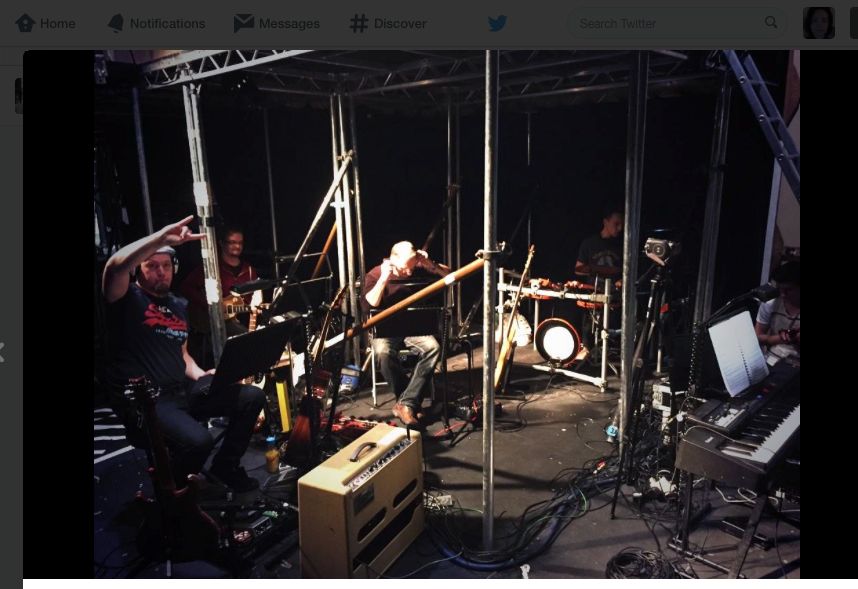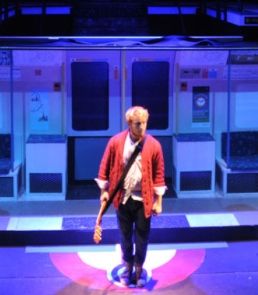I recently worked on a production of Lift a musical set in and around the lift of Covent Garden underground station. It was directed by Paul Baker at the Ivy Arts Centre in Guildford originally being produced at Soho Theatre in London.
Lift is a rock musical rather than a more traditional musical with an orchestra. The music is composed with a guitar-heavy band, strings on click, and an actor/musician “the Busker” who plays an acoustic guitar on stage. The show also has a large SFX element; tubes, lifts, and announcements all combine to create the bustling soundscape of a London tube station.
There was around a week of pre-production, with some prebuild of the set. I got a few hours after everything was set up to tune the system and then band call. I like to have a slow and calm band call this is time we never get back and if you get this right you have the building blocks for the rest of the show in place. The cast joined in with mics later in the afternoon and we ran through the entire show. It was a good day, and I felt I was at a good starting point. The tech started on Monday morning, and we had an audience in on Wednesday night, not long to get a lot of tech together for all departments.
There were several sound challenges presented by Lift. The set was on multiple levels, with the performance area set not only in the auditorium but also in the balconies on each side. Achieving imaging and eliminating feedback in this situation was going to be a challenge.
The upper level presented a feedback challenge just by virtue of being so close to the in-house line array. The stage itself was not very deep, which made speaker placement difficult. I had to compromise on the mic positions for the actors, they were further down their heads than I like, this helped a lot with gain before feedback. The balconies in the auditorium were used for a full singing ensemble and were in front of the line arrays. I had to rig more speakers to make other “ front of house rigs” on each side of the auditorium. With panning, timing and some skillful mixing from the no1 (FOH engineer), we managed to keep the imaging of the cast spread out around the auditorium. This allowed the imaging to follow the cast as they moved around and to get lots of gain before feedback.
The cleanest way to allow the Busker to play live and wander about the stage without trailing a cable everywhere was to feed his pick-up into a radio pack which went into a pouch, stitched into his guitar strap. The Busker played both solo and with the band. A video feed of the musical director (who was positioned behind some of the set) at the back of the auditorium made this and cueing of all the numbers easier.
While guitar cabs on stage are not a problem with close mic’d singing into cardioid microphones, we were using omnidirectional radio mics, and they presented some challenges. The musicians had to be cooperative regarding their levels, and they needed to be aware of how their dynamics were affecting the cast on stage. After meeting with the musical director Barney Ashworh, I realized he knew what he was doing, understood the process and I was sure we could make it work. Which was great as it meant we wouldn’t have to go the way of virtual guitar cabs. A microphone on a cab, in my opinion, just sounds better.
The band position was on stage but behind the set of the tube and underneath the raised platform, so there was some wood and padding between them and the acting area. This helped to contain the spill from the band and also allowed the guitar players to be at a level where they could get their desired sound.
A major sound element was the tube trains arriving and leaving Covent Garden station. I was excited by this and along with the great set and projection by PJ McEvoy I thought it would be fun to achieve. The first time I tried the sound of the tube arriving in the station it didn’t really work. I am always anxious to hear the SFX in the space with the speakers in position ASAP. It can be hard to predict what a room and set is going to do to the SFX that sounded perfect through your headphones.
| The speakers didn’t have enough rumble to pass for a tube train, and I didn’t have enough speaker locations to create a smooth transition across the stage. I needed something meatier and more point sources. We got in some more speakers and layed them on the floor behind the tube and at the next sound session, I was pleased with the effect. Adding in some pan to make the tube sound move with the projection of the stations whizzing by helped to create the illusion. PJ and I were constantly talking about how long each train took to arrive, how long was it before the doors opened and how long did the train take to leave the station. By communicating and making each other aware of things that had changed we managed to tech these tricky sequences without it being too painful. Each member of the cast had a radio mic worn with the heads in their hair and the packs in belts around their waist or clipped to bra straps. So while we didn’t need to swap mics to different cast members, we did need to accommodate costume changes and partial nudity. It was a busy plot backstage as well. Although it was a fast tech with many elements, the show came together well, and I was very pleased to be part of the production.
|

